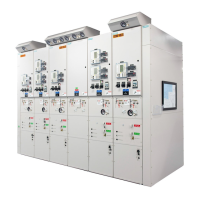861-9601.9 • INSTALLATION AND OPERATING INSTRUCTIONS • 8DA10 • Revision 11 49/214
Installation
19.6 Comments on electromagnetic compatibility
To achieve appropriate electromagnetic compatibility (EMC), some basic requirements must
be observed while erecting the switchgear. This applies especially to the installation and
connection of external cables and wires.
Basic measures for ensuring EMC are already taken during design and assembly of the
switchgear panels. Among other things, these measures include:
• The low-voltage compartment is an integral part of the panel, which means that the
protection and control devices with the internal wiring are metal-enclosed.
• Reliable earth connections of the frame parts via toothed contact washers or locking
washers.
• Inside the panel, wires are laid in metal ducts.
• Spatial separation of sensitive signal wires from wires with high interference voltage levels.
• Limitation of switching overvoltages of inductive loads (e.g. relay or contactor coils, motors)
by means of protective circuits with diode, varistor or RC element.
• Within the low-voltage compartment, the secondary devices are mounted in defined zones.
• Shortest possible connection between corresponding modules in subracks.
• Consideration of the magnetic leakage fields of conductor bars and cables.
• Protection of subracks and wiring backplanes against interference by perforated shielding
plates.
• Large surface bonding between all modules and devices as well as bonding to the earthing
conductor of the switchgear assembly.
These measures basically enable proper operation of the switchgear itself. The planner or
operator of the switchgear must decide whether additional measures are required depending
on the electromagnetic environment where the switchgear is installed. Such measures must
be implemented by the installation company in charge.
In an environment with heavy electromagnetic interference it may be necessary to use
shielded cables and wires for the external connections. This makes it possible to avoid
interferences in the low-voltage compartment and thus, undesired influences on the
electronic protection and control or other automation devices.
Cable shields must be electrically bonded to be able to carry high frequencies, and contacted
concentrically at the cable ends.
The shields of cables and wires are connected and earthed in the low-voltage compartment.
Connect the shields to earth potential - with high electrical conductivity and all around as far
as possible. Protect the contact surfaces from corrosion in case of humidity (regular
condensation).
When laying cables into the switchgear assembly, separate the control, signaling and data
cables and other lines with different signal and voltage levels, e.g. by laying them on separate
racks or riser cable routes.
Corresponding to the different shield designs, there is a number of methods to perform
connection. The planning department or site management determines which of the methods
will be used, taking EMC requirements into account. The preceding points should always be
taken into account.
The shield is connected to cables or wires with clamps contacting all around. If low demands
are placed on EMC, it is also possible to connect the shield directly to earth potential (combine
or twist the shield wires) or via short cable connections. Use cable lugs or wire-end ferrules at
the connecting points.
Always keep the connecting leads of the shields as short as possible (< 10 cm).
If shields are used as protective earth conductors at the same time, the connected plastic-
insulated lead must be marked green/yellow over its entire leng
th. Non-insulated connections
are inadmissible.

